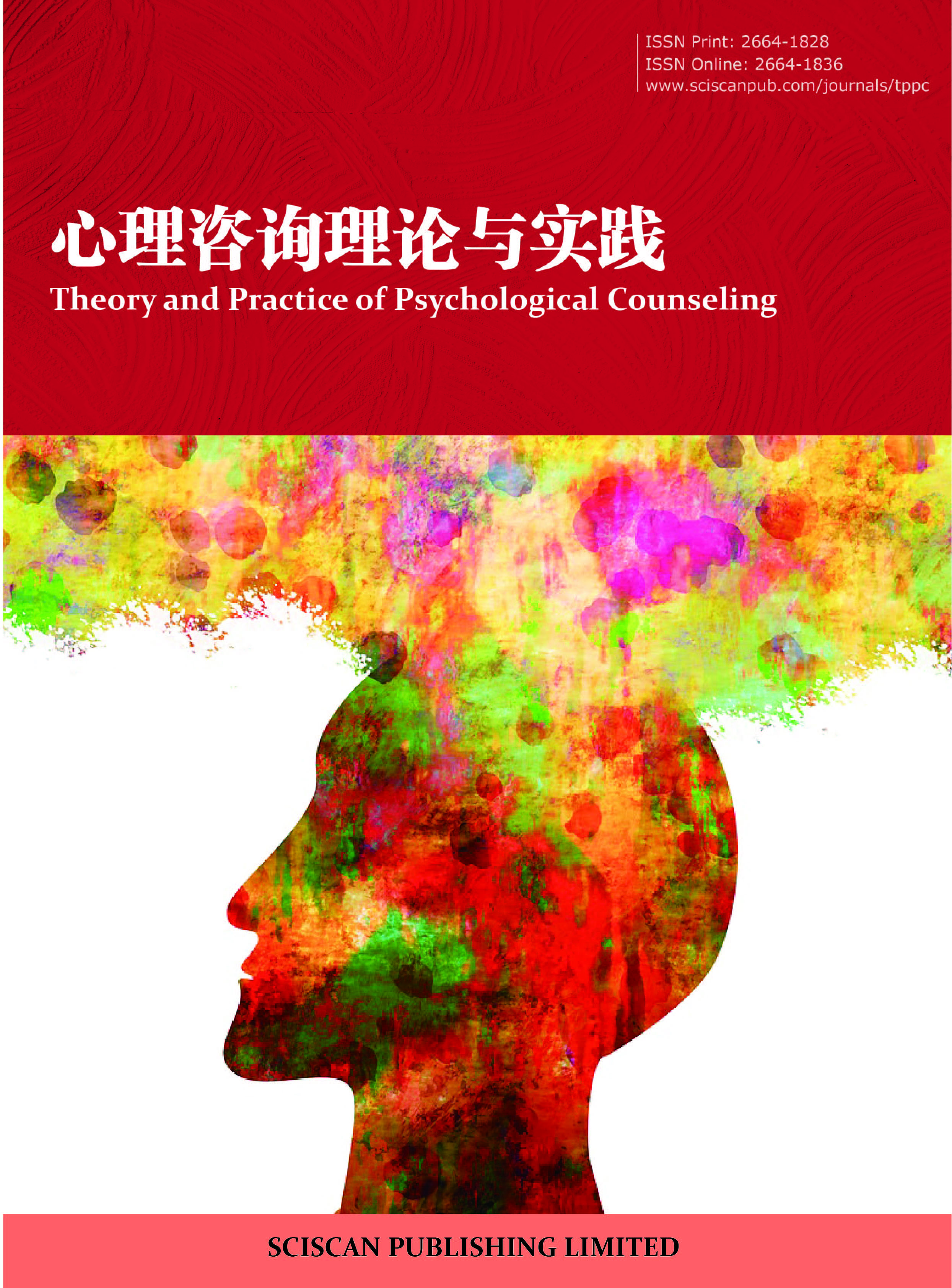Theory and Practice of Psychological Counseling
青少年抽动障碍的心理病因和预防 ——基于精神分析视角
Psychological Etiology and Prevention of Tic Disorder in Adolescents: From the Perspective of Psychoanalysis
- Authors: 罗希
-
Information:
同济大学人文学院心理学系,上海
-
Keywords:
Tic disorder; Psychological cause; Psychoanalysis; Prevention抽动障碍; 心理病因; 精神分析; 预防
- Abstract: Tic disorders (TD) are a group of synonyms that appear in childhood or adolescence and are mainly characterized by motor and/or vocal tic movements in one or more parts. Tic disorders bring great burden to patients and society. This paper reviews the studies of several psychoanalysts to explore the psychological etiology of tic disorder. This paper argues that tics, as a symptom, is a kind of neurosis with potential unconscious conflict. When the instinct is censored by the superego, it is expressed in a localized, rapid, involuntary, and repetitive movement, with elements of gratifying release and sadism, under the function of the immature ego at an early stage. Therefore, tic disorders can be classified as pregenital transition symptoms. On the basis of this theory, this paper puts forward systematic prevention and treatment measures, and believes that it is necessary to make joint efforts from teenagers themselves, parents and schools to prevent and treat tic disorder, so as to provide a new perspective for the diagnosis and treatment of tic disorder in China. 抽动障碍(Tic Disorders,TD)是一组起病于儿童或青少年时期,以一个或多个部位运动抽动和(或)发声抽动为主要特征的综合征,给患者与社会带来了极大的负担。本文回顾多位精神分析家的研究,深入探讨抽动障碍的心理病因。本文认为,抽动作为一个症状,是一种伴有潜在无意识冲突的神经症。当冲动被超我所稽查,在早期不成熟的自我功能的作用下,冲动就会以一种局部的、快速的、不自愿的、反复的运动方式进行表达,且其中有满足的释放和施虐元素。因此抽动障碍可以被归为前生殖器期的转换症状。在此理论基础上,本文提出了系统的防治措施,认为需要从青少年自身,家长以及学校层面共同努力,进行抽动障碍的防治工作,为国内抽动障碍的诊疗提供新视角。
- DOI: https://doi.org/10.35534/tppc.0309078
- Cite: 罗希.青少年抽动障碍的心理病因和预防——基于精神分析视角[J].心理咨询理论与实践,2021,3(9):625-631.
1 引言
抽动障碍( Tic Disorders,TD)是一组起病于儿童或青少年时期,以一个或多个部位运动抽动和(或)发声抽动为主要特征的综合征,抽动常常表现为突然的、快速的、反复的、非节律性的运动或发声,可伴有强迫障碍、注意缺陷障碍和情绪障碍等诸多问题[1-3]。抽动障碍会导致生活质量的降低和低自尊,并且因此导致身体、情感、社会、健康功能等多方面的问题[4,5]。抽动障碍的发病原因是多方面的,既有遗传因素、生理因素导致的精神神经异常的影响,又有免疫、环境因素和心理因素的协同影响[6]。但国内对于抽动障碍的临床干预存在着许多不足,治疗手段主要以药物治疗为主,心理健康教育为辅或不予以心理干预[7]。虽然药物对于抽动症的治疗有一定的疗效,但疗效不一致、不确切且不同的药物都伴有不同的副作用,所以药物有其自身的局限性[8,9]。非药物治疗主要包括有心理教育和支持治疗、行为治疗和神经调控技术[10,11]。国内外也有研究表明,精神分析疗法、家庭治疗[12]、自我催眠疗法和箱庭疗法[13]等谈话疗法[14]对抽动障碍也都有显著的治疗作用[12]。行为治疗当中习惯逆转训练(Habit Reversal Training,HRT)和暴露反应预防(Exposure Response Prevention,ERP)虽被证明是针对青少年长期抽动障碍的有效干预方式[15],但也难以根治[7]。也有研究表明,虽然短暂性抽动障碍被认为是会随着患者的年龄增长而缓解,但有部分患者的病情并没有在患者长大后缓解,而是以更复杂多样的抽动持续存在[16]。虽然许多疗法都能改善抽动障碍的症状,也有许多研究从遗传因素、神经免疫因素和神经生物学因素等方面去钻研其病因和发病机制,但针对抽动障碍的研究与诊疗始终没有取得令人满意的效果[6]。也有许多文章从家庭维度探索了影响患者的多种相关因素[17],但并未系统地建立患者心理病因的模型。没有一个系统的心理病因模型,就不能对患者全面地进行心理上的干预和防治。对此,精神分析学说尝试从治疗的角度去发现抽动障碍的心理病因,也试图从发展的角度去理解患者的人格如何形成。但国内基于精神分析学说对抽动障碍的研究几乎为零。所以本研究基于精神分析的视角,深入探讨抽动障碍的心理病因,并试图在此基础上提出一些系统的防治措施,为国内抽动障碍的心理治疗和干预提供新的视角。
2 基于精神分析视角抽动障碍的心理病因
2.1 精神分析关于抽动障碍研究简述
第一位系统研究抽动障碍的精神分析家是桑多尔·费伦齐(Sándor Ferenczi)[18]。费伦奇是20世纪的匈牙利精神分析家。他在临床中观察发现大量的精神分裂症患者和偏执狂都有着抽动症状,所以把抽动症类比于紧张症,认为抽动是身体部分的紧张。费伦奇提出假设认为抽动障碍的本质是自恋,因为抽动症患者是用自己的身体来释放自己的性兴奋,所以是一种原发自恋症状(Primary Narcissism),病因和自恋式精神病相同。而抽动的运动表达是身体在对这些部位的刺激进行防御反应。
这个观点一出便在柏林精神分析大会上引起了激烈的讨论[19],其中来自德国的精神分析家卡尔·亚伯拉罕(Karl Abraham)给与了一些不同的看法。亚伯拉罕首先认为抽动障碍有底层的客体关系(Object-relationship),并且认为费伦奇并没有说清楚应该把抽动症归于哪一个疾病分类体系里面。所以需要讨论清楚几个问题(1)抽动障碍和强迫症的关系,因为这两者症状十分相似。要进行区分需要判断患者力比多的发展水平是否在肛欲期(Anal Stage);(2)抽动障碍和癔症的关系,因为抽动症患者可能是以转换的方式来使用自己的身体表达性兴奋。要进行区分需要断定患者在外在干预下停止抽动后,是否有焦虑的情绪;(3)抽动障碍和精神病的关系,到底是否是原发性的自恋。但是因为当时的精神分析家大多只对成年人进行分析,没有关于儿童和青少年太多的个案研究,所以争论并没有得出有效的结论。
四年后,亚伯拉罕和费伦奇的弟子即著名的儿童精神分析家梅兰妮·克莱因(Melanie Klein),通过对儿童抽动障碍的临床治疗把精神分析关于抽动症的理论向前推了一大步。基于对菲力司、华特等个案的成功治疗和研究,克莱因清楚地探讨了抽动与病人整体人格 、性、神经症、升华、性格发展和社会态度之间的关系[20]。并且回答了上述的三个问题,首先,抽动症和强迫症一样有肛欲期的施虐冲动;其次因为在人为干预下强行停止的抽动症患者并没有表现出焦虑,而是表现出一种紧绷感,所以抽动障碍和癔症有相同的转换(Conversion)机制;最后抽动症当中的秽语症(Tourette Syndrome,TS)能证明抽动症有底层的客体关系(Object-relationship),所以是继发性自恋(Secondary Narcissism)。克莱因也由此发现,抽动症患者不仅会通过抽动症释放肛欲期的施虐冲动(Anal-sadistic Stage),而且伴随着有自慰的幻想。据此她提出抽动症患者有着强烈的压抑,并且和性格发展有着密切的关系。也提出了当患者升华作用成功的时候,抽动就会瓦解、消失。克莱因通过个案观察还发现,患者的心理发展要到达潜伏期才会发展出真正的抽动,而到达青春期之后因为创伤的事件会再次激活抽动。
接着,另一名儿童精神分析家玛格丽特S·玛勒(Mahler,Margaret S)基于前期精神分析家的观点,通过随访、个案研究、理论探讨、数据分析等多种方式研究抽动症,提出了一套全面的精神分析关于抽动症的理论[21-25]。她认为,抽动障碍可以分为以下三种:(1)早期的抽动,来源于一种对过度情感表达和企图进行控制间形成的冲突的替代表达,所以在孩子很小的时候就表现出不安的过度运动性。通常这个时期父母要求孩子进行控制,孩子可以主动停止一段时间。当孩子成长到了6—7岁,这种类型的抽动就会因为自我的成长防御功能的完善而消失。这一组的抽动患者有丰富的表现运动能力,而这一能力会帮助他们的自我更快地成长。(2)在孩子进入学校之后经过一定程度调整发展而来的抽动,这些学生都会有一段烦躁不安和不成熟的学前历史。因为他们本就带有焦虑的状态,且自我的功能并不是很成熟。所以这个时候如果遭到了体罚或者其他的压力事件,那么就会促进冲动的爆发。而这一类的抽动一般形成于孩子放弃自若活动(Auto-erotic)之后的几周,以身体抽动的形式表达。但之后抽动的形式会变得复杂,不过主要表现为对第一次抽动的防御和二次润饰(Secondary Formation)。这一组的患者,他们的表达会被抑制,所以很难让他们开口说话和活动,因为他们处在防御和害怕被冲动压倒的恐惧中。(3)这一类抽动出现在成人和青年中,有着强烈的器官神经症的特征,所以他们的肌肉群被象征性(Symbolic)的使用。这种抽动症状与自我功能是分离的,所以我们很难达到治疗的效果。接着她完善了抽动障碍的诊断系统,给出了治疗方式,提出了系统的症状形成理论和抽动症与性格发展的关系,也提出了一些防治方式。她认为首先,心理咨询的目的是使孩子的无意识冲突意识化,其次我们要尽可能地消除病理环境的影响,最后要增加运动冲动的释放机会。
2.2 心理病因简述
抽动行为在心理上面都是起源于创伤体验,这种创伤体验会唤起恐惧受伤的感觉。但是因为儿童的自我功能并不成熟,肌肉控制也不熟练,所以小肌肉的抽动被用于回应和防御各种不同的恐惧事件。这也是儿童自我逐渐操控自己身体的一个过程。不过有些严格的父母在抚养的过程当中会禁止儿童的这种活动,孩子也会害怕父母不爱自己或者遭到惩罚,所以逐渐过渡到使用大型的肌肉群来进行攻击和防御。这种被抑制下来的能量如果正常发展,孩子们可以通过去从事一些竞争性的游戏,使用升华将能量释放掉。自我的发展如果不受到阻碍,对身体兴奋控制的能力就会越来越强。孩子就可以通过这种抑制维持父母的爱,也可以在社会中有自己的追求和爱好。
孩子的早期自我要处理俄狄浦斯冲突(Oedipus Conflict)的性冲动,需要在直接释放和将兴奋绑定释放之间反复尝试,才能最终成为一个成熟自我。但孩子如果在成长的过程当中突然遭遇了伴有强烈敌意的创伤性事件,就可能会打破这一平衡。孩子的自我就会去努力地整合这两种冲动,来获得父母的爱,和表达自己的敌意。但孩子的自我还是不成熟的,智力发展和认知能力都不够成熟,没有办法帮助他去整合这两种强烈的情感。所以孩子的自我必须要做出一个妥协的解决方案,也就是去部分地满足相互冲突的冲动,部分表达相关的情绪。与此同时也就产生了抽动的症状。孩子这样做既可以对冲动进行部分的替代和转换,也可以通过一种不受禁忌的方式来获得父母的爱。但由于当时的自我把能量大部分都用于处理内在的冲突,所以在性格发展和学习能力方面都会变得迟滞。而且自我也会把这种防御的方式用于所有焦虑的情况。早期的自我无法处理这些焦虑,也通常会使用禁止、部分替代和否认的防御机制。这也就导致了抽动障碍包含了自恋式精神病的维度,也有强迫症的施虐冲动还有癔症的转换机制,还伴有焦虑的情绪。这些都是因为早期自我的防御功能并不成熟所导致的。而如果父母对孩子的运动表达进行大规模的抑制,就会导致自我对运动和身体控制的能力减弱,难以成为成熟的自我。并且孩子的运动系统是一个特殊的运动系统,早期的许多冲突都需要运动的释放。在自我彻底的掌控运动活动之前,孩子通过局部的肌肉释放紧张感是合理的。
综上所述,抽动作为一个症状,是一个简单和明显的神经症,伴有潜在的无意识冲突。冲动被超我所稽查(Censorship),通过早期不成熟的自我功能(禁止、部分替代和否认)的处理,冲动就会以一种局部的、快速的、不自愿的、反复的运动方式表达。并且这场运动中有满足的释放和施虐元素。所以抽动障碍在精神分析当中被归为,前生殖器期(Pregenital Stage)的转换症状[26]。抽动是一种“幼年的神经症”,包含着自恋式精神病、强迫症和癔症等各类神经症的特点。以至于我们可以在临床上面看到,作为转换症状的抽动和作为一种凝缩的强迫动作和行为的抽动。患者成长过程中因为自我一直处于症状之中,所以没有得到足够的时间来组织必要的防御机制,或者发展出一个例如歇斯底里症或强迫性神经症类型的系统化神经症。如果自我一直没有放弃这种防御方法,抽动就会持续地存在,并与自我分离,成为一个附属症状,即使成年后通过精神分析解决了他的主要神经症冲突也无法治疗抽动。
3 精神分析视角对抽动障碍的预防
精神分析对抽动障碍的理论和治疗的探讨对预防抽动症形成有很重要的意义。预防抽动障碍的形成要从儿童和青少年入手,在未成年阶段帮助他们以健康的方式应对无意识的冲突,帮助和促进他们形成成熟的自我,让他们对冲突能更好地进行控制和升华,来预防顽固抽动障碍的形成。
3.1 培养青少年积极地通过竞技性运动掌控自己的身体
从幼儿开始,学校、家庭和社会就有义务培养青少年的运动能力,因为青少年可以通过运动的方式缓解自己无意识的冲突、逐渐学会掌握自己的身体,以及建立积极成熟的防御机制。青少年的自我相对来说并不成熟,所以很多时候会倾向于直接通过运动的方式来释放冲动。而如果能够进行竞争性的运动,那么既可以让青少年在游戏的氛围中表达自己的冲突,也可以通过运动的方式获得身体的控制力,逐步完善自我的发展。
3.2 鼓励青少年利用升华的机制
升华可以让青少年的一些不被社会接受的冲动转移到对社会有价值的对象上。所以升华既可以让青少年的冲动得以释放,也可以让青少年能够获得社会的认可。家长和老师应该在这方面给予青少年更多的鼓励,让青少年在积极投入到一些例如足球、篮球、乒乓球等和身体运动方面相关的兴趣爱好当中去。同时教育者们要鼓励那些发育较慢或者体弱多病的同学也力所能及地参与进去,让青少年们在活动中激发热情获得自我的提升。
3.3 帮助家长接纳孩子的不完美
抽动障碍的家长常常会有完美主义的倾向[27],这会让孩子生活在一个极具压力的氛围中。孩子的自我就会更加关注于防御自身那些不被父母接受的冲动或行为,而得不到健康的发展。在这样的家庭中孩子的攻击性无法得到表达,就可能会转化成抽动的表达形式。而孩子的父母并不会接纳这种表达方式,所以孩子的压力会继续增大,继而形成一个恶性循环。而当家长认识到抽动可能是一个孩子正常发展中的一个过程,并给予孩子一些接纳和鼓励时,往往抽动的频率就会减少甚至消失。并且也要让家长们了解到在自我彻底掌控运动活动之前,孩子通过局部的肌肉活动来释放他的紧张感是合理的。
3.4 学校要密切关注青少年的心理,充分利用心理咨询的工具
如果能在抽动出现的早期,孩子还没有形成抽动障碍的时候尽早识别与干预,那么抽动便可能不会发展为抽动障碍。青少年也可能会因为在学校、家庭以及自身发展当中的压力,让本就不成熟的自我变得更为脆弱,增加患抽动障碍的可能性。所以学校要密切地关注他们的心理,当发现有异样的时候使用心理咨询进行及时的干预和帮助,培养、教育和引导学生的心理能力和心理品质[28]。
3.5 教育者要杜绝体罚或惩罚等不正当教育方式
青少年对于自己身体的控制能力尚处在一个逐渐成长的过程中[21]。如果这个时候教育者采用体罚甚至严厉惩罚的方式来企图达到教育的效果,结果肯定会事与愿违。因为这样会让青少年的身体控制能力变得紊乱、内心更加焦虑,对自我的成长和发展也是不利的。所以教育者应该在对青少年的教育方式当中增加更多的鼓励和接纳,回绝不正当的教育方式。
3.6 帮助青少年们认识自身的冲突
青少年心理发展的每一个阶段都会有自身的危机和冲突[29],例如婴儿期的基本信任对不信任、儿童期的自主对害羞和怀疑、学龄初期的主动对内疚、学龄期的勤奋对自卑、青春期的自我同一性对角色混乱等。我们要帮助青少年们认识其人身发展各个阶段当中的冲突,促进他们对冲突的整合以及冲动的释放。青少年们的身体成长迅速,冲动也会随之变得高涨,他们不成熟的自我难以处理这些冲动和冲突。但是如果我们能用正确的方法让他们认识到自身的这些冲动,并进行引导,这些冲动就会变为推动他们形成成熟自我的关键力量。
参考文献
[1] 石森.抽动障碍的发病机制及治疗[J].国际精神病学杂志,2014,41(3):164-167.
[2] Francesmonneris A ,Pincus H,First M.Diagnostic and Statistical Manual of Mental Disorders:DSM-V[M].American Psychiatric Association,2013.
[3] 靳彦琴.抽动障碍儿童情绪问题分析[J].中国妇幼保健,2014,29(31):5092-5093.
[4] Evans J,Seri S,Cavanna A E.The effects of Gilles de la Tourette syndrome and other chronic tic disorders on quality of life across the lifespan:a systematic review[J].European Child & Adolescent Psychiatry,2016,25(9):939-948.
[5] Hesapolu S T,Tural M K,Kandil S.Quality of life and self-esteem in children with chronic tic disorder[J].Turk Pediatri Arsivi,2015,49(4):323-332.
[6] 张燕,邱秀娟.儿童抽动症病因及治疗研究进展[J].山东医药,2015,55(42):103-105.
[7] 徐雯,赵俊秀,孙锦华.抽动障碍的行为治疗研究进展[J].中国临床心理学杂志,2018,26(2):417-420.
[8] 梁月竹,张世吉,郑毅,等.奎硫平治疗抽动障碍的临床研究[J].中国心理卫生杂志,2005,19(9):602-603.
[9] 赵欣,吴敏,张欣,等.抽动障碍药物治疗现状分析[J].国际精神病学杂志,2016(4):617-619.
[10] 张晓月,郭岚敏,张秋,等.抽动障碍非药物治疗的研究进展[J].中国康复医学杂志,36(2):232-236.
[11] 苏群燕,冯建华.儿童和青少年Tourette综合征治疗现状[J].临床儿科杂志,2019,37(5):396-399.
[12] 詹明心.抽动障碍儿童依恋和家庭特点的对照研究[D].南京医科大学,2010:68.
[13] 袁莉敏,孟瑶.抽动症儿童的箱庭治疗个案研究[J].心理与行为研究,2020,18(4):564-569.
[14] Smith H.Investigating young people’s experiences of successful or helpful psychological interventions for tic disorders:An Interpretative Phenomenological Analysis study[J].J Health Psychol,2016,21(8):1787-1798.
[15] Nissen J B,Carlsen A H,Thomsen P H.One-year outcome of manualised behavior therapy of chronic tic disorders in children and adolescents[J].Child and Adolescent Psychiatry and Mental Health,2021,15(1):9.
[16] Kim S.Provisional Tic Disorder is not so transient[J].Scientific reports,2019,9(1):3951.
[17] 吴莉城.儿童抽动障碍心理特征及家庭特点的研究[D].浙江中医药大学,2014:60.
[18] Ferenczi S.Psycho-analytical observations on tic[J].The International Journal of Psychoanalysis,1921(2):1-30.
[19] Abraham K.Selected papers of Karl Abraham,M.D.[M].Hogarth Press and the Institute of Psycho-analysis,1927.
[20] 梅兰妮·克莱因.爱、罪疚与修复[M].北京:九州出版社,2017(3):113-135.
[21] Mahler M S.Tics and Impulsions in Children:A Study of Motility[J].The Psychoanalytic quarterly,1944,13(4):430-444.
[22] Mahler M S,Gross I H.Psychotherapeutic study of a typical case with tic syndrome[J].Nervous Child,1945(4):359-373.
[23] Margare S M,A L Jean.Outcome of the tic syndrome[J].The Journal of Nervous and Mental Disease,1946,103(5).
[24] Margaret,Schoenberger,Mahler.A Psychoanalytic Evaluation of TIC in Psychopathology of Children[J].Psychoanalytic Study of the Child,2017.
[25] Mahler M S,Luke J A,Daltroff W.Clinical and follow-up study of the tic syndrome in children[J].American Journal of Orthopsychiatry,1945,15(4):631-647.
[26] Feindel M.Tics and Their Treatment[M].Wm.Wood,1907.
[27] Garivani G,A M T E.The effectiveness of treatment based on acceptance and commitment to psychological flexibility and perfectionism in mothers of children with tic disorders[J].Fundamentals of Mental Health,2020,22(6):421-428.
[28] 王宋芳,刘致静,乔志宏.中小学心理健康教育现状及未来发展趋势[J].中国教师,2018(5):18-23.
[29] 埃里克森.同一性:青少年与危机[M].浙江:浙江教育出版社,1998:1-337.
















